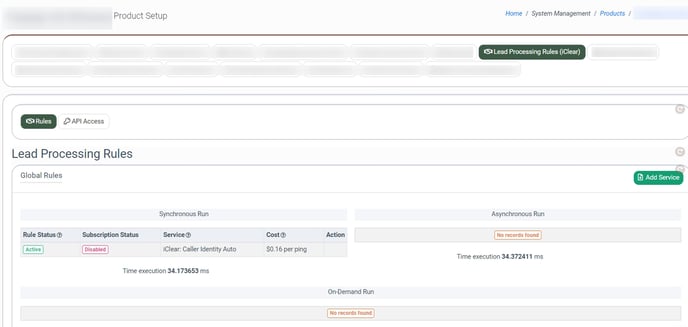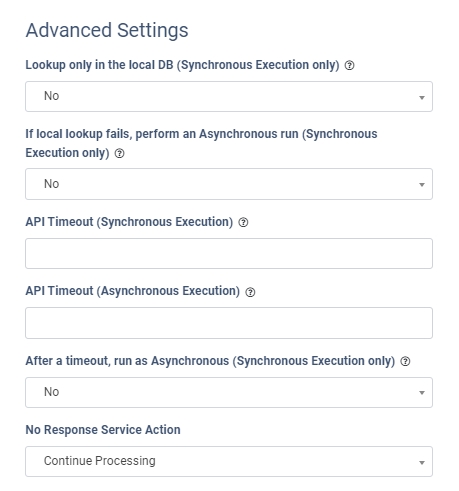The iClear: Caller Identity service allows you to perform real-time validation of an individual’s first name, last name, address, and other identity-related details by a provided phone number using a third-party database.
To enable this service, go to the System Management > System Subscription section, click the “Additional Features” button for the Call Logic platform, select the “iClear: Caller Identity” service from the list, and click the “View/Edit” button.
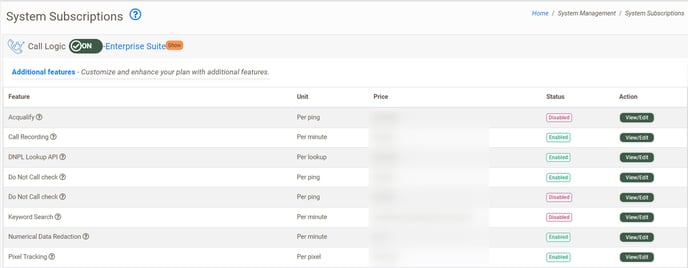
Or click the “Enable Service” button in the “Caller Identity” column in the Publisher Reports > Call Details report.
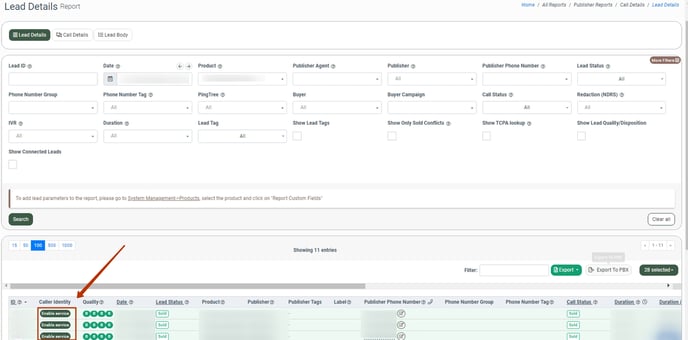
To select the Product for which you want to activate the “Caller Identity” service, check the “Auto-Setup for Products:” box and mark Products. To set the automatic setup of the service for all Call Logic Products that will be added to the system, check the “Auto-Setup for Future Products” box as well. Click the “Activate” button to complete the process.
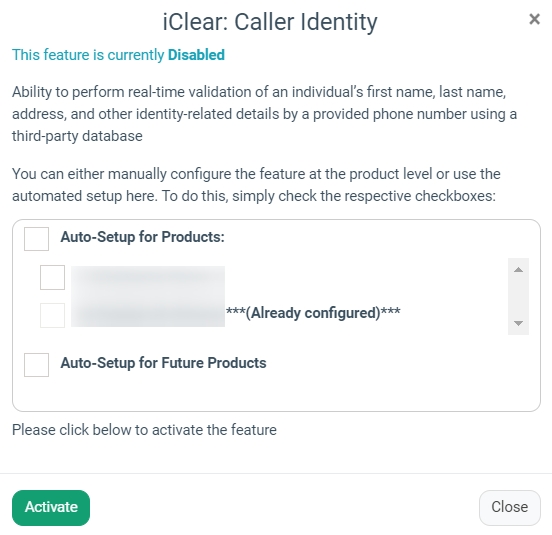 To add or configure the processing rule for the service, go to the Fraud and Anomaly > iClear > Lead Processing Rules section and select a Product from the drop-down list.
To add or configure the processing rule for the service, go to the Fraud and Anomaly > iClear > Lead Processing Rules section and select a Product from the drop-down list.

Once you select the Product, you’ll be automatically redirected to the Lead Processing Rules (iClear) sub-tab.
You may also navigate here by selecting the System Management > Products section on the left-hand menu and clicking on the “Settings” button for the corresponding Product (Lead Processing Rules (iClear) sub-tab).
To configure this service, click the “Add Service” button in the Global Rules block of Product Settings. Fill in the following fields:
- Select Third Party Service: Select the “iClear: Caller Identity” option.
- Select a field to retrieve the phone number: Select which field the system will retrieve the phone number from. Example: cellPhone.
- Execution Type:
- Select the "Synchronous" option to wait for the caller identity lookup outcome before processing a lead. This execution type is recommended for real-time filtration of a lead based on the lookup status. Before processing a lead, the system makes a request to the third-party database.
- Select the "Asynchronous" option to make a simultaneous request and process a lead without waiting for the lookup outcome. This execution type is recommended for analytical purposes and not for real-time lead filtration based on the lookup status. While processing a lead, the system makes a request to the third-party database.
- Select the “On-Demand” option to enable leads filtration when the “% of lead to lookup” is set as 0 (null).
- % of leads to lookup: Set the percentage of leads to be checked through this service.
- Reject the lead if the phone number was last seen less than X days before: Fill in the maximum number of days the phone number was last seen to be rejected.
- Reject the lead if bankruptcy cases are found: Select “Yes” to reject the lead in case the bankruptcy cases are found in connection to this phone number.
- Reject lead if LastName is not equal to: Select the field to check its equality with the LastName data.
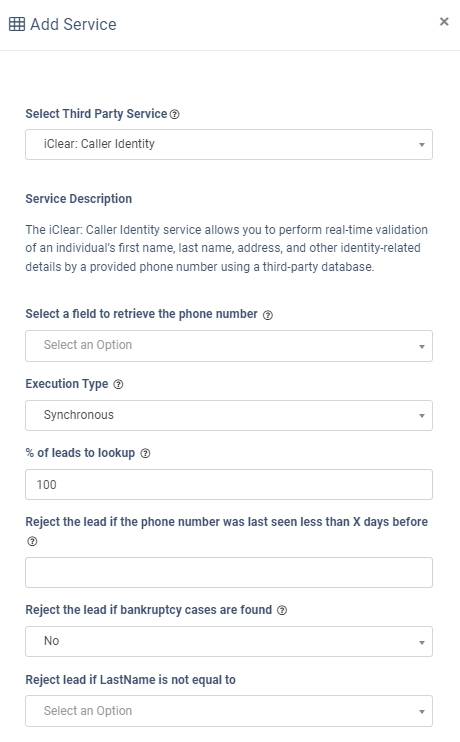
The “Advanced Settings” configuration block allows you to customize the lookup and timeout settings of the service according to the selected Execution Type.
- Lookup only in the local DB (Synchronous Execution only): Select “Yes” for the service to lookup only in the local database. Select “No” for the service to lookup both in the local database and API.
- If local lookup fails, perform an Asynchronous run (Synchronous Execution only): Select “Yes” to perform the Asynchronous run in case the local database lookup is unsuccessful. Select “No” to disable the lookup override.
- API Timeout (Synchronous Execution): Fill in the service response timeout (from one to five seconds). The field is active only if the “Lookup only in local DB” option is disabled.
- API Timeout (Asynchronous Execution): Fill in the service response timeout (from one to five seconds).
- After a timeout run as Asynchronous (Synchronous Execution only): Select “Yes” to perform the Asynchronous execution if the timeout runs out. Select “No” to disable the Asynchronous run override.
- No Response Service Action:
- Select the “Continue Processing” option if you want to continue processing leads when the service doesn`t respond.
- Select the “Reject Lead” option if you want to reject the lead when the service doesn`t respond.
The “Additional Run Settings” configuration block allows you to configure more options to determine at which stage you would prefer to run the service.
- Service run time: Select whether you would prefer to run the service before or after the leads are filtered out (After filtration / Before filtration).
Note: Please be aware that selecting this option may impact your invoice. Once this option is selected and no campaigns remain for the service to run, there will be no charges incurred. - Run service on (PingPost products only): Select one of the options to determine at which stage you would prefer to run the service for the Ping Post products (Ping / Post / Ping and Post).
- Run service on silent ping: Select “Yes” if you would like to run the service during the silent ping stage. Select “No” to exclude this option.
Click the “Add” button to confirm.
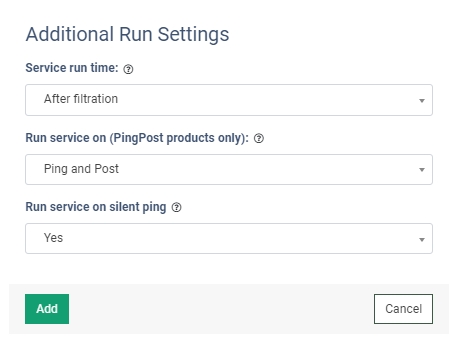
You can view the results of the Caller Identity check in the All Reports > Publisher Reports > Call Details report, “Lead Details” tab.
Click the “Get Caller Identity” button in the “Caller Identity” column to check the information for the lead. Click the “Get details” button in the pop-up window.

After the request is processed, the result is displayed in the “Caller Identity” column of the report. If the service retrieves information, the lead`s name will be displayed. Otherwise, the system will show the “No records found” note in the report. To view the full information about the lead, hover the cursor over the lead`s name.
To retrieve the lead`s data manually, go to the Fraud and Anomaly > iClear Manual Check section. Select the “iClear: Caller Identity” in the “Third Party Service” field, select the Product, and enter the phone number of the lead. Click the “Send Request” button to complete the process.
 Read more about the Global Rules and Advanced Rules configuration in this Knowledge Base article.
Read more about the Global Rules and Advanced Rules configuration in this Knowledge Base article.

